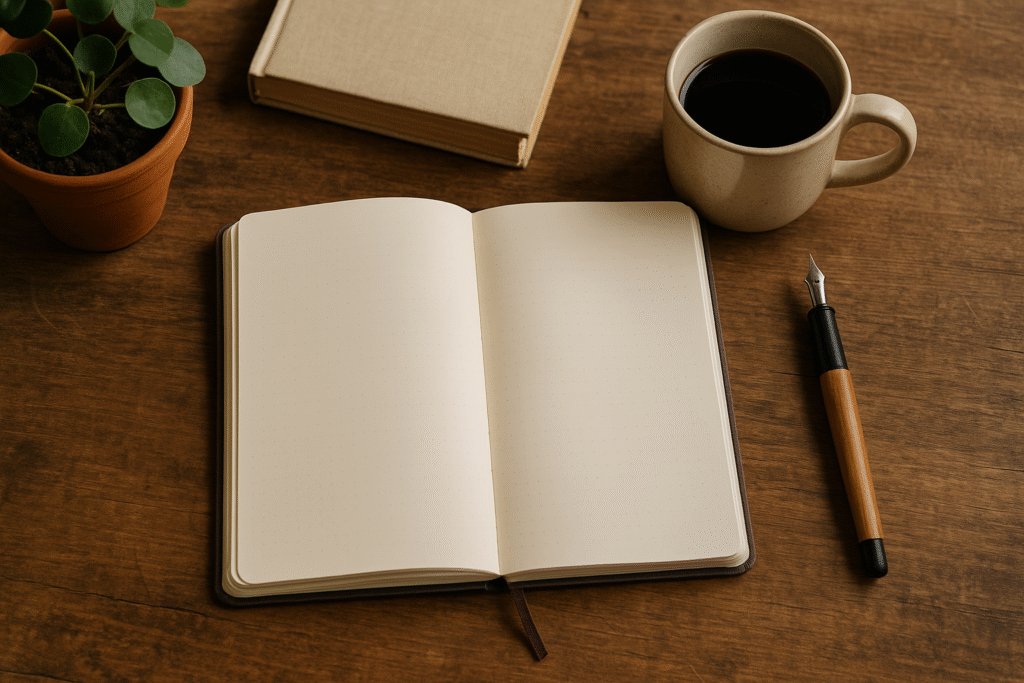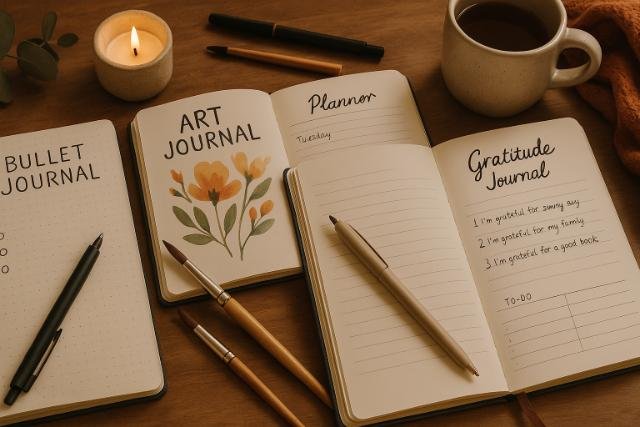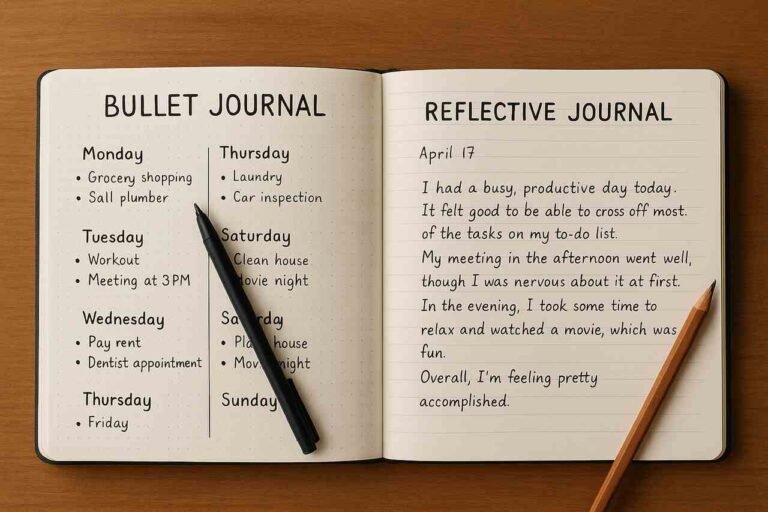Introduction
In a world filled with digital distractions and constant noise, journaling has become a sanctuary for clarity, mindfulness, and productivity. Among the most popular styles, Bullet Journaling and Reflective Journaling stand out for their contrasting yet complementary purposes. While bullet journaling focuses on structure, organization, and productivity, reflective journaling nurtures self-awareness, emotional intelligence, and introspection. Understanding the key differences between these methods can help you determine which approach best aligns with your personal or professional goals. This guide explores every aspect of both styles, from tools and techniques to benefits and psychological impact, so you can confidently decide which form of journaling works best for you.
Set Up the Foundation for Your Journaling Practice

Before deciding which journaling style to embrace, establishing the right foundation ensures consistency and long-term commitment. Both bullet and reflective journaling require intention, preparation, and the right mindset.
A proper foundation begins with selecting tools that resonate with you, whether it is a classic notebook, a dotted planner, or a digital journal app. Your writing environment matters too: choose a calm, distraction-free space that inspires focus. The key is to make journaling accessible and inviting so that the act itself feels rewarding rather than forced.
Consistency builds the habit. Setting aside a specific time each day or week, even for just ten minutes, can create a sustainable journaling rhythm. Whether you are logging daily tasks in a bullet journal or reflecting on your emotions, the foundation you build determines how effective your practice will be.
Choose the Right Journaling Tools
Your tools shape your journaling experience. A Bullet Journal typically works best with dotted or grid notebooks, allowing for flexible layouts and visual structure. On the other hand, Reflective Journaling benefits from lined or blank pages that encourage free-flowing thought.
Digital alternatives like Notion, Obsidian, or GoodNotes also offer templates and synchronization for those who prefer journaling on tablets or laptops.
Establish a Consistent Routine
A journaling routine transforms a habit into a ritual. Morning sessions enhance focus for bullet journaling, while evening reflections deepen insight for reflective journaling. Pair your routine with cues such as a specific place, sound, or time to reinforce the behavior.
Define the Purpose Behind Each Journaling Style

Every journaling method thrives on clarity of purpose. Bullet journaling excels at task management, productivity tracking, and goal planning, while reflective journaling serves as a tool for emotional awareness, personal growth, and mental clarity.
Bullet journaling follows a systematic framework created by Ryder Carroll, emphasizing efficiency through rapid logging, signifiers, and key migration techniques. Reflective journaling, however, embraces fluid expression, allowing thoughts to unfold without constraint or structure.
Understanding why you are journaling will guide your choice. If your goal is to stay organized, bullet journaling aligns perfectly. If you are aiming for inner understanding, reflective journaling offers a more intuitive path.
Focus on Practical Objectives
In bullet journaling, objectives are measurable: completing tasks, tracking habits, or outlining projects. It is results-driven and ideal for those managing multiple responsibilities or seeking productivity improvement.
Emphasize Emotional and Cognitive Goals
Reflective journaling focuses on internal processing rather than external results. It encourages analyzing emotions, questioning motives, and identifying patterns in behavior, supporting emotional intelligence and resilience.
Master the Structure and Layout Techniques
The structure is the heart of bullet journaling, while reflective journaling thrives on freedom. Learning how each system organizes thoughts and information is crucial for choosing the right fit.
A Bullet Journal typically includes an Index, Future Log, Monthly Log, and Daily Log, forming a system of interconnected sections for streamlined organization. Reflective journaling, by contrast, uses open-ended prompts or free writing sessions that prioritize self-expression over order.
Here is a comparison table to illustrate the core structural differences:
| Aspect | Bullet Journaling | Reflective Journaling |
| Structure | Highly organized with indexes and logs | Free-form with open-ended entries |
| Focus | Productivity and task management | Self-awareness and emotional growth |
| Tools | Dotted notebook, signifiers, templates | Blank or lined notebook |
| Time Commitment | Short, frequent entries | Longer, introspective sessions |
Implement a Bullet Journal Framework
Start by designing your Index and Future Log to map out upcoming events. Use Monthly Logs for priorities and Daily Logs for quick notes. Symbols like bullets, circles, and arrows help categorize tasks, events, and ideas efficiently.
Create Reflective Prompts and Themes
Reflective journaling flourishes through prompts such as “What did I learn today?” or “How did I feel about my decisions this week?” Rotating themes like gratitude, resilience, or growth deepens insight over time.
Track Progress and Analyze Patterns
Tracking is the cornerstone of bullet journaling, but it also enhances reflective journaling when done thoughtfully. Both methods offer valuable insights into your progress, mindset, and habits.
A Bullet Journal Tracker visualizes data, from sleep patterns to fitness routines, providing a quantifiable record of consistency. Reflective journaling tracks emotional or mental states qualitatively, helping you understand triggers, growth, and recurring themes.
By merging these insights, you can identify whether your lifestyle aligns with your goals or if adjustments are necessary.
Build Effective Habit and Goal Trackers
Use habit trackers, goal charts, or progress bars in your bullet journal to measure tangible achievements. Visual representation motivates consistency and highlights areas needing improvement.
Reflect Through Periodic Reviews
Reflective reviews once a week or month enhance mindfulness. Re-reading previous entries reveals patterns of thought, recurring challenges, or emotional evolution, offering clarity on personal growth.
Integrate Creativity and Personalization
Creativity transforms journaling from a task into an art form. Both bullet and reflective journaling benefit from visual or expressive elements that make the process enjoyable and unique.
In bullet journaling, creativity enhances productivity. Color coding, doodles, and typography increase engagement while maintaining structure. Reflective journaling uses creativity therapeutically through storytelling, sketches, or even poetry to articulate emotions.
By personalizing your journaling method, you increase motivation and foster deeper connection with your entries.
Design Visual Elements in Bullet Journals
Add trackers, icons, and decorative layouts to create an aesthetically pleasing and functional design. Colors can represent categories such as blue for work, green for wellness, and red for goals to improve clarity and recall.
Use Expressive Techniques in Reflective Journals
Experiment with sketches, metaphorical writing, or collage art to visually represent your thoughts and emotions. This freedom enhances self-expression and deepens your connection to your writing.
Evaluate the Psychological and Emotional Benefits

Both bullet and reflective journaling contribute to psychological well-being but in distinct ways. Bullet journaling reduces anxiety through structure, while reflective journaling enhances emotional intelligence through introspection.
Research shows that organized systems reduce cognitive load, helping users feel more in control. Reflective journaling, on the other hand, encourages deeper processing of experiences, which promotes healing and personal transformation.
Choosing between the two depends on your mental and emotional goals. For instance, professionals dealing with overwhelm may prefer bullet journaling, while individuals exploring self-identity might find reflective journaling more rewarding.
Enhance Focus and Productivity
Bullet journaling supports executive function, helping the brain prioritize, plan, and act. This method is especially beneficial for those managing ADHD, deadlines, or multiple commitments.
Strengthen Emotional Awareness and Healing
Reflective journaling engages the limbic system, promoting emotional regulation and empathy. Writing about experiences helps release suppressed emotions and fosters a stronger sense of self-understanding.
Combine Bullet and Reflective Journaling for Maximum Results
Rather than choosing one method over the other, many journalers find success by combining both. A hybrid approach allows for the best of both worlds: productivity and mindfulness.
For example, use bullet journaling for scheduling and task tracking, and reserve a separate section for daily reflections. This integration builds a holistic system that supports both external organization and internal growth.
Here is a simple hybrid layout example:
| Journal Section | Function | Example Entry |
| Daily Log | Track tasks and appointments | “Finish client report, call vendor” |
| Reflection Page | Process emotions or insights | “I felt anxious during the meeting but stayed composed.” |
Design a Dual-Format Journal
Divide your notebook into two halves, one for bullet entries and one for reflections. This keeps your system organized while allowing creativity and emotional exploration.
Sync Digital and Analog Systems
Combine apps like Notion or Evernote for structured notes and use handwritten reflections for personal depth. The combination bridges efficiency and mindfulness seamlessly.
Sustain Motivation and Long-Term Practice
Maintaining a journaling habit over time requires self-awareness, adaptability, and inspiration. Many people abandon journaling because it becomes repetitive or time-consuming. By setting realistic expectations and celebrating progress, you can make journaling a lifelong habit.
Revisit your initial purpose regularly and adjust your journaling format as your life evolves. Whether it is simplifying layouts or changing prompts, flexibility ensures sustainability.
Refresh Your Journaling Approach
Experiment with new templates, monthly themes, or digital integrations to keep the practice exciting. Change pen colors or journal styles to maintain novelty.
Build a Supportive Community
Engage with online journaling groups or local workshops. Sharing layouts, reflections, and challenges fosters accountability and creativity, motivating you to continue journaling consistently.
Conclusion
Choosing between Bullet Journaling vs Reflective Journaling ultimately depends on your personal goals and lifestyle. If you seek organization, focus, and goal achievement, bullet journaling provides structure and clarity. If your priority is emotional depth, mindfulness, and self-discovery, reflective journaling offers a transformative path. Yet, combining both methods can yield the most powerful results, balancing productivity with introspection for a well-rounded, fulfilling journaling experience.
Both styles lead to growth, awareness, and empowerment, not just on paper, but in how you approach life.
Explore more insightful and valuable content on our blog journalingtechniques! Stay updated with helpful tips, expert advice, and in-depth articles that enhance your knowledge.
FAQ’s
Yes. You can dedicate different sections or spreads for each purpose, task tracking on one side and reflections on the other. This hybrid model offers the benefits of both organization and mindfulness.
There is no fixed rule. Ten minutes of consistent journaling daily is often more effective than occasional long sessions. Choose a duration that fits naturally into your schedule.
Absolutely. Many creatives enjoy customizing layouts, using color palettes, and adding artistic elements to express themselves while staying organized.
Start small. Focus on forming the habit rather than perfection. Setting reminders or pairing journaling with an existing routine can improve consistency.
Reflective journaling generally provides deeper emotional release and mental clarity, while bullet journaling reduces stress by organizing chaos. Both can significantly lower anxiety when practiced regularly.
It depends on your preference. Paper journals encourage mindfulness and tactile engagement, while digital platforms offer convenience, backups, and easy editing.

